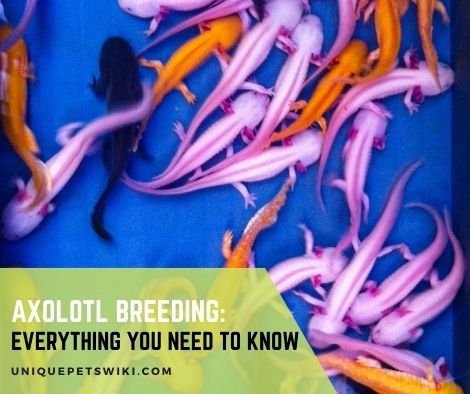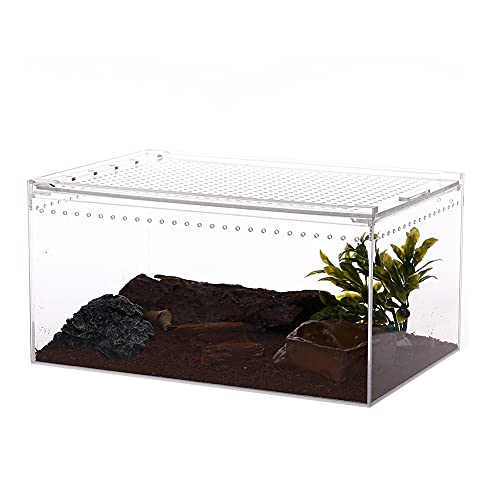Axolotls breed in their natural habitats, so it’s possible to breed them in captivity.
Breeding axolotls is something that most scientists enjoy doing, and it has prompted them to produce several different morphs of axolotls.
It’s an exciting practice but a bit challenging at the same time.
Before you embark on breeding, you need to be familiar with these water amphibians and equip yourself with their breeding knowledge.
Breeding can be heart-breaking if you don’t get what you want due to a mistake made. Although it’s not complicated to breed these creatures, some areas require your special attention.
This article contains a comprehensive guide on axolotl breeding. You will learn the mating time and behavior, gestation period, egg-laying, the best time to breed an axolotl, and more.
Contents
Axolotl Breeding: Everything You Need to Know
Ideally, an axolotl is best for breeding after attaining a length of seven inches. This time, the female’s reproductive organs are fully developed, and she can carry a pregnancy without straining.
The parameters such as frequency, food quality, and the aquarium’s water quality help determine how long your axolotl will take to become sexually mature.
Axolotls typically produce offspring once a year in the wild. Breeding in captivity is also successful, and axolotls can breed whenever conditions are ideal.
The availability of axolotls in pet stores is proof that breeding axolotls are doable in captivity, and it’s a good practice.
The mating behavior in these animals is fascinating, where the males typically flirt with females.
Females produce young ones by laying eggs a few days after mating and fertilizing the eggs.
The eggs will eventually hatch after a couple of days, and they need to be set under the right temp, usually at 22℃ (about 72 degree F).
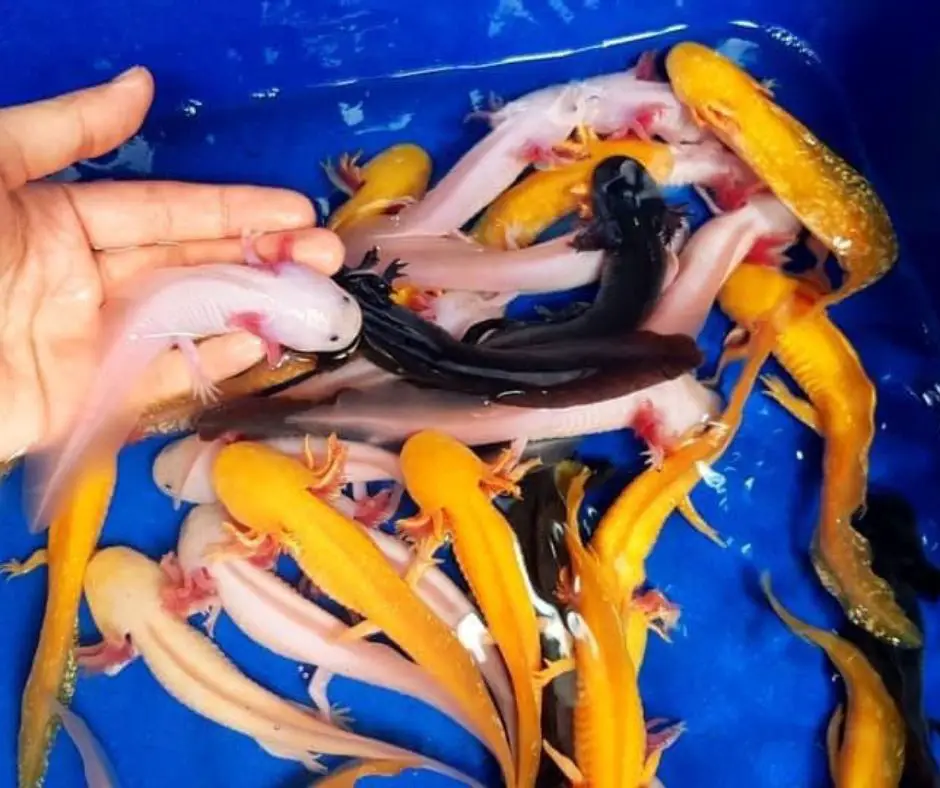
When Is an Axolotl Old Enough for Breeding?
By the time an axolotl is 12 months old, it is sexually mature, but it’s advisable to start breeding them when they’re around 18 months.
The male axies become sexually mature earlier than females; some are ready for mating at five months old. The length of an axy can also tell you when it is ready for mating.
Axolotls that are longer than seven inches are most likely ready to mate/breed. The aquatic environment can affect the growth rate in axolotls and how soon they reach sexual maturity.
To support successful breeding, you have to imitate the conditions of the natural habitat of axolotls, including changes in the seasonal temps and natural light conditions.
Poor tank conditions induce stress and, if prolonged, can make the axolotl lag behind in health and mature very late.
It’s always best to place your axy in a room receiving natural light to help the axolotl signal changes in temps and daylight length.
It’s also necessary to have plants and decors in the tank where females can easily lay their eggs.
There is no specific age for animals to experience menopause, including axolotls.
They don’t have a particular period when they stop reproducing. Most of these pets die before they stop reproducing.
The only successful way to stop axolotls from breeding is by housing males and females separately.
Axolotl Mating Habit
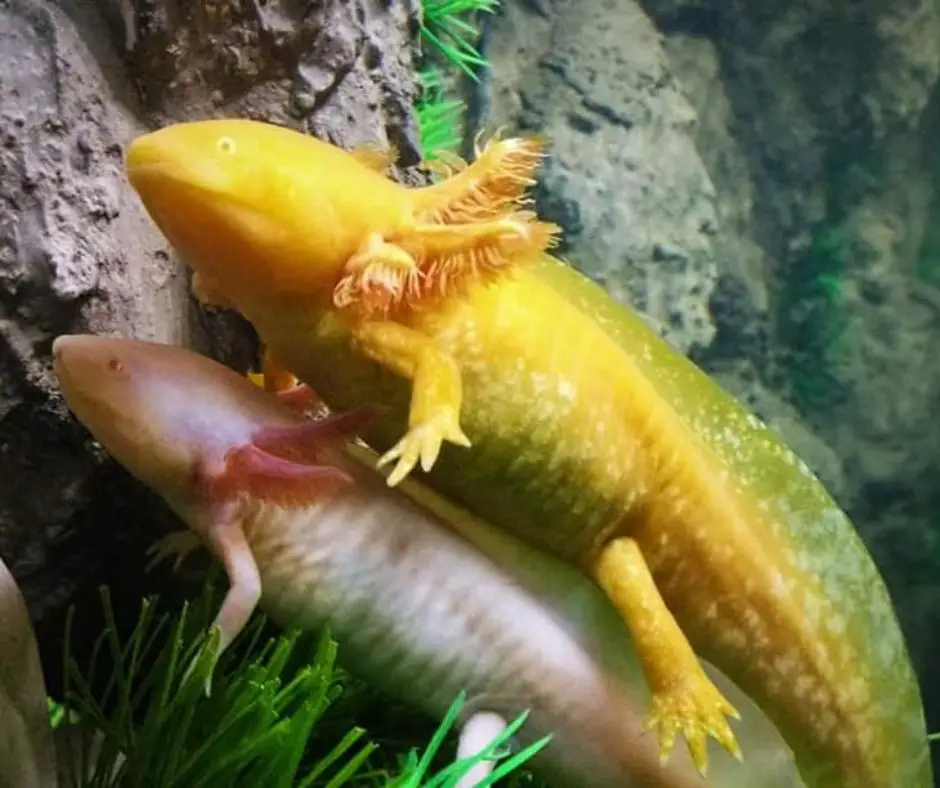
Wild axolotls breed once in 12 months, especially in the early summer. However, captivated species are different since you can breed them whenever you want after they are fully sexually mature.
And this is only possible in circumstances when the tank conditions are right.
The mating behavior in these amusing pets can be described as a ‘courtship dance of sorts’ where the male aims to attract the female onto his sperm packets.
The male axie will swim around the female while raising its tail and making robust twisting motions when it wants to mate.
Consequently, the same male prods the female hindquarters with his nose to see if she is willing to mate.
The female may also respond by nudging the male’s hindquarters, eventually leading to a courtship dance. After the male allures the female to mate, he positions himself in front of her.
He then releases sperm packets/spermatophores into the tank and directly to the female cloaca, and she takes them up into her cloaca.
They are immobile sperm packets and don’t stick on surfaces making the female easily take them up.
The male will release 5-25 spermatophores, and the female picks up several of them that will fertilize her eggs.
The whole mating process can take about an hour. The male axolotl will only produce these packets of sperms in the presence of a female.
How to Breed Axolotls
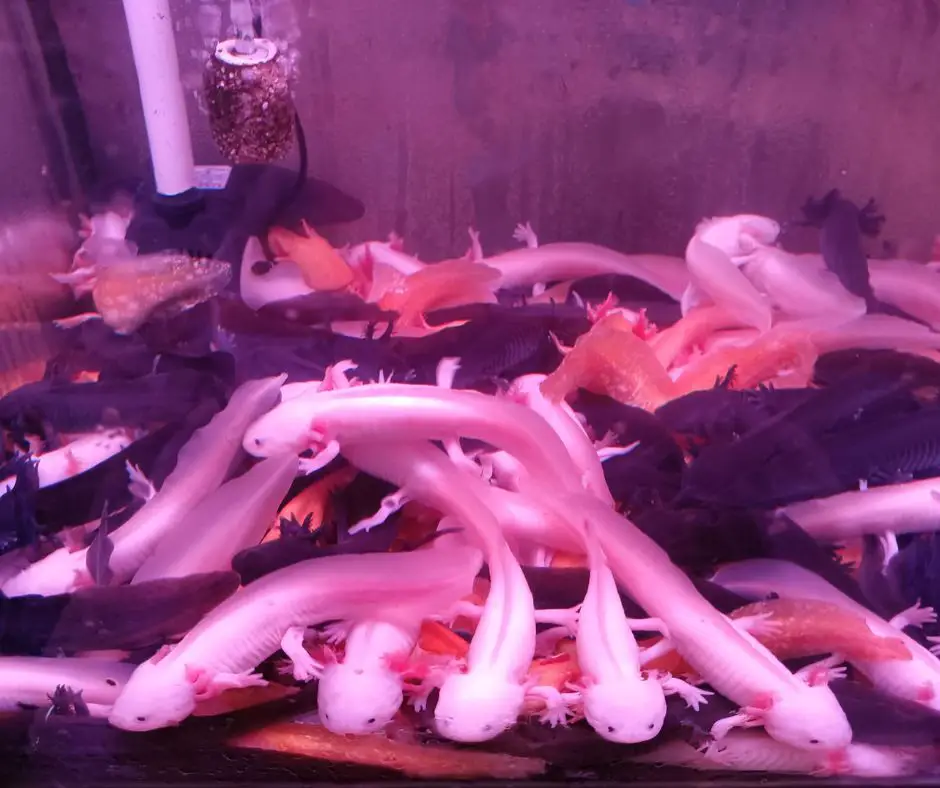
If you want to breed axolotls successfully, it’s necessary to ensure you expose them to a favorable environment from the beginning and provide good husbandry practices.
Above everything, keep an eye on the tank settings. An axolotl is required to live in captivity the same way it would live in the wild.
Nothing should change, including the lighting conditions, temperatures, and aquarium constituents.
What I mean is that you should emulate their natural habitat as closely as possible.
For example, put the axy’s tank in a room that receives natural light to allow the axolotl signal daylight length and temperature changes.
Ensure you provide quality water and avoid noises as much as possible that can disturb the axolotl. The artificial aquarium lighting does not help stimulate the natural breeding pattern in axolotls.
The ideal temp to kick-start axolotls breeding falls between 12-14℃. Drop the amount of daylight exposure to your axies separately for 2-3 weeks before bringing them together.
To encourage mating, get the male and female axies near each other, and feed them a bucket of tropical fish separately.
This makes them enter into ‘love mode.’ Bring the two axolotls to each other for breeding.
Once the female finishes spawning, separate the two partners to allow time for the female to recuperate before the subsequent fertilization.
Axolotls Pregnant and Lay Eggs
After mating, you will know the eggs were fertilized if they hatch into hatchlings.
When it comes to axolotls, the female is pregnant with eggs for a short time, and then she spawns—the eggs hatch after 17 days.
There are not many symptoms to check for pregnancy in axolotls, except that the female carrying eggs usually seem rounder and plumper around the belly, but the eggs may be fertilized or not.
A typical female axolotl’s belly size is almost the same as its head. But if they are carrying eggs, the belly is bloated.
Female axolotls usually don’t lay eggs in the absence of a male. However, some females are reported to do so, although this is an exception to the norm. And in such cases, the eggs will be few and unfertilized.
Also read: How To Identify Dead Axolotl Eggs?
How Long Are Axolotls Pregnant For?
Axolotls are among the animals with the shortest gestation period. After successful breeding and fertilization, the female axolotls become pregnant with eggs, not babies.
The male sheds spermatophores in the water, and the female absorbs them through her cloaca. The fertilization of the eggs happens internally.
Once the breeding and fertilization are over, axolotls will take around 12-72 hours to spawn/lay eggs.
That is the advantage of their short gestation since you don’t wait for a long time before knowing whether your axolotl is pregnant or not.
Also read: Pregnant Axolotl Symptoms
How Many Eggs Does an Axolotl Lay?

Even after not being pregnant for a long time, axolotls lay many eggs. A pregnant axy will lay anywhere from 1-450 eggs in a single spawning.
The number of eggs a female axolotl can lay is between 100 and 1000 eggs. The female doesn’t choose a specific place to lay the eggs, but she spawns them everywhere in the tank, on the decors, leaves, pipes, and rocks.
The moment you breed axolotls, you should be fully prepared to receive the young ones soonest.
These salamanders usually lay eggs over a short period, such as a few hours or perhaps some days. What happens is that immediately after the first batch, the female’s body will begin replacing the eggs.
VIVOSUN 1-Pack LCD Digital Aquarium Thermometer
- High Accuracy: Temperature Range: -50℃ ~ +70℃ (-58 °F ~ +158 °F); This aquarium thermometer is accurate to +/- 1℃, no matter whether the probe is placed in any corner of this fish tank, an accurate temperature will be displayed
- LCD Display: Comes with a large LCD display that is easy to read clearly and accurately
- Adjustable Unit Tempature: Easy to adjust the temp between Fahrenheit and Celsius displays; Long-press the power button to adjust the unit display
- Two Suction Cups: Equipped with two suction cups, one for attaching the cable to the side of the tank and another for attaching the thermometer
- Super Long Cable: The cable length connected to the probe is 78.74 inch (2 m) superior to 23.62 inch (60 cm) standard cable length; Allows accurate temperature measurements in even the largest fish tanks
Last update on 2022-12-29 / Affiliate links / Images from Amazon Product Advertising API
How often Do Axolotls Have Babies?
Axolotls breed once every year in the wild. Their natural breeding season is between December to June. And this tells you that a wild female axy will welcome her little ones to the world once a year.
The captivated axolotls can have babies at almost any time as long as you set the tank conditions right and there is a male to fertilize the eggs.
However, overbreeding the female axie is detrimental to her health. If she is frequently breeding and spawns an abundance of eggs, it can immensely drain her body.
Therefore, give a sufficient period for the axolotl to recapitulate after spawning. You can allow her to rest for six months and breed her again. And this will make the axolotl have babies twice per year.
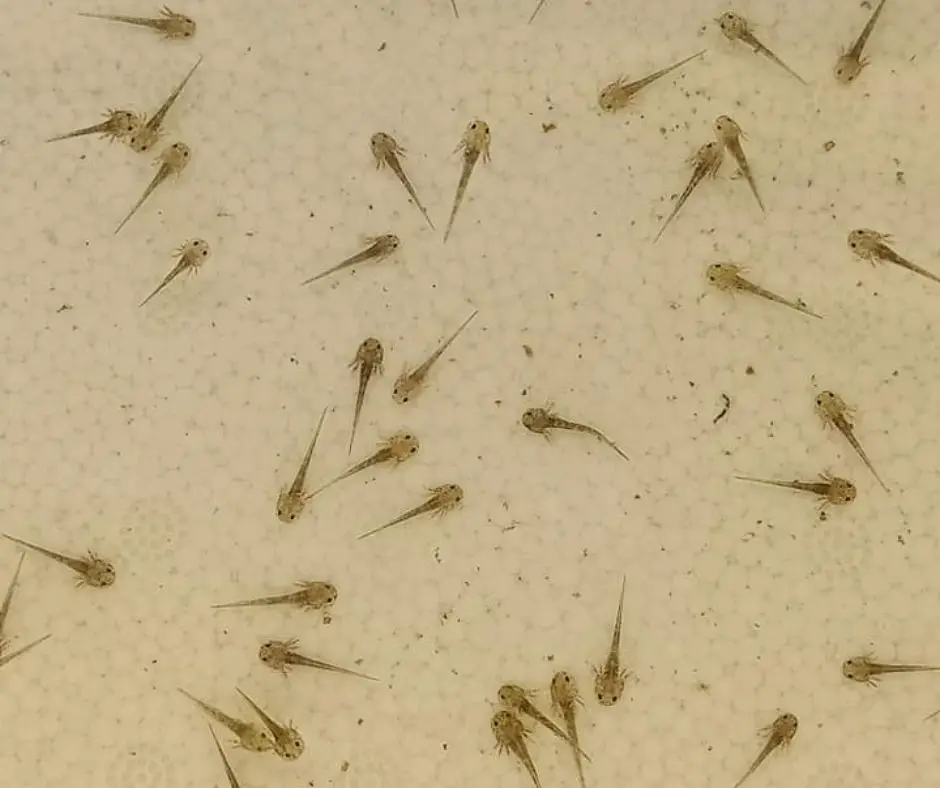
What Should You Do When Your Axolotl Laid Eggs?
As previously mentioned, axolotls do not lay their eggs at one point. They will lay eggs in plants and other vegetation available in the aquarium.
A female axolotl will lay her eggs when and where she can.
A healthy axolotl lays dark brown eggs apart from albino morphs whose eggs are white. Any unusual color reflects a problem with the eggs. The adult axolotls tend to eat eggs.
The eggs are not sectioned off, and the fact they are all over the tank makes it wise to remove the parent.
Some people immediately introduce the female in a glass water bowl and notice spermatophores on the accessories or loose in the aquarium water.
The female does not absorb all the sperm packets.
After spawning, they separate the eggs into different water bowls, which is where the little ones will hatch from. Each bowl should not exceed 50-100 eggs to avoid overcrowding.
Also read: How To Remove Axolotl Eggs From Tank
Axolotl Eggs Hatching
The incubation period of axolotl eggs varies depending on temperature and tank conditions. A high temp accelerates the development of embryos, while a lower temp delays this process.
If you incubate the eggs at a water temperature of 20℃, they should hatch after 17 days.
However, it will take a few more days for the eggs to hatch in more-cooler water. You also need to keep the water quality pristine.
Good aeration will also help the eggs to hatch sooner. The presence of an air pump and air stone in the tank facilitates aeration; however, ensure the water current is not strong.
Poor water condition brings about extremely poor survival and growth rate of the axolotl larvae. You have several tasks to do when the eggs start to hatch.
For example, it will be necessary to perform partial water changes every few days to ensure the babies continue to grow in clean water.
If the hatching was in the same setup, separate the little ones into several 20 gallons once they reach a size, they could be moved.
Preventing overcrowding is imperative to avoid unnecessary injuries and fatalities.
Also read: Raising Axolotl Eggs: Complete Guide for Beginners
NANEEZOO Magnetic Acrylic Large Enclosure 2.5 Gallon breeding box
- 360-Degree full view visually completely transparency to ovserve the behavior of your pets easily.
- Size: 12" x8" x 6", appx.2.5 gallon, suitable for tarantulas, scorpions, crickets, snails, mantis frogs, geckos, spiders and other small aninals.
- Sliding design and strong mangnetic closure for easy access and anti-escape, convenient and lightweight.
- There are a number of ventilation holes on top and both sides, which provides sufficient air circulation.
- Made with high grade acrylic material to provide sturdy and durable home for your pets.
Last update on 2023-01-02 / Affiliate links / Images from Amazon Product Advertising API
Wrapping Up
Today, axolotl breeding is a common practice, and it’s easy to conduct if you have the proper knowledge and equipment.
When breeding, attention should be given to parents and the offspring to ensure both receive the proper care.
Axolotls mate inside water, where the male produces packets of sperms that he releases in the water, and the female absorbs them through her cloaca.
Typically, the male releases these spermatophores when a female is present.
When fertilization is successful, the female is gravid with eggs for 12-72 hours, and then she lays them inside the water, everywhere on rocks, branches, decors, etc.
Depending on the incubation temperature, the eggs take 2-3 weeks to hatch.
One axolotl can lay approximately 100-1000 eggs, and upon incubation, 95% of the eggs will survive if the conditions are right.
